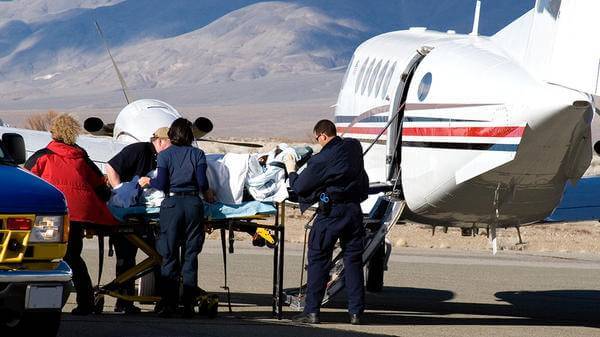What exactly does ‘critical care’ mean in a medical transport setting?

Eileen Frazer, Executive Director of the Commission on Accreditation of Medical Transport Systems (CAMTS), shared the latest changes the organization is making to its standards, which define exactly what ‘critical care’ is for the purposes of accreditation
The definition of critical care varies depending on the discipline of the clinician you ask – paramedic, registered nurse (RN), or physician. It also depends on whether the clinician practices in an urban or rural setting, or even which part of the US or the world they reference. The response ‘you know it when you see it’ brings to my mind a picture, but it may bring a different picture to the minds of others, all of whom claim to be critical care providers.
CAMTS’ definition
When the 11th Edition Accreditation Standards were published in 2018, we divided critical care into two separate categories as follows:
- Emergency critical care (ECC): Capability to deliver out-of-hospital care during the acute resuscitation phase before definitive care is provided (comparable to emergency department stabilizing care or an ICU transfer to more definitive care).
- Intensive critical care (ICC): Capability to deliver out-of-hospital care comparable to tertiary ICU care during interfacility transport to a higher-level tertiary ICU.
The intent was to continue to accredit at the ECC level only, but track and trend the numbers of clinical and quality metrics submitted with each accreditation application. Using this data, along with the care providers’ disciplines, experience, and training, the Board felt it would be able to define and differentiate ‘emergency’ from ‘intensive’ critical care in the 12th Edition Standards, and then begin to accredit at one or the other level of critical care.
Using this data, along with the care providers’ disciplines, experience, and training, the Board felt it would be able to define and differentiate ‘emergency’ from ‘intensive’ critical care
For example, performing certain procedures may indicate an ‘intensive’ level of critical care. Extracorporeal membrane oxygenation (ECMO) was one of the few interventions suggested as representative of ICC. But more and more programs were performing ECMO transports, and if they were using the appropriate team with current training and equipment, they would be in compliance with the standards. In many cases, some of the larger programs had bases that were able to perform ECMO and some that did not, depending on the needs and capabilities in a specific coverage area. It would be difficult to achieve accreditation as an entire company under separate types of critical care in this case, unless each base is accredited as either emergency or intensive critical care, presenting a logistical nightmare.
Data needed on critical care transports
As the Board discussed the ICC issue, there were other factors such as the number of each intervention performed, and education to perform and stay proficient. Even if a program only did a few advanced procedures a year – didn’t extensive and consistent training qualify as ICC? Although ECMO, intra-aortic balloon pump or Impella transports are typically performed infrequently – how few is not enough to differentiate between the types of critical care? Studies were not out there to answer these questions.
After many meetings and individual correspondence with the Association of Critical Care Transport, one of our member organizations, and the accredited programs that primarily provide interfacility transports to a higher level of care, the Board decided to combine ‘intensive’ and ‘emergency’ critical care into just one critical care definition.
The Board decided to combine ‘intensive’ and ‘emergency’ critical care into just one critical care definition.
The 12th Edition Standards, to be published later in 2022, will combine criteria formerly under the separate critical care headings into just ‘critical care’.
The CAMTS Standards Committee will post the final draft of the 12th Edition in April–May 2022 for public comments for approval at the July 2022 Board meeting. The 12th Edition will be available as of October 2022 and will be in effect as of January 2023.
CAMTS and CAMTS global standards are the same or similar in topic and format with differences in the CAMTS Global standards that are found outside North America. The CAMTS Global Board will be approving the 2nd Edition Accreditation Standards in October 2022. Please see the 2nd Edition draft on the www.camtsglobal website and submit your comments and suggestions.

May 2022
Issue
In this issue:
Dynamic hoisting; wireless communication solutions enhancing crew coordination; we say au revoir to the RCAF CC-115; introducing pre-hospital ECMO - nationwide coverage in the Netherlands; CAMTS' Executive Director Eileen Frazer looks at what critical care means; HEMS pilot Mike Biasatti explains how hard work and dedication pay off; and Dr Julian Wijesuriya on Airway Management interactive online learning course.
Eileen Frazer
Eileen Frazer, RN, CMTE, is the Executive Director of the Commission on Accreditation of Medical Transport Systems (CAMTS). Eileen is a former Chief Flight Nurse who served as the Safety Committee Chair for the Association of Air Medical Services and did the feasibility study in 1988 that led to the development of CAMTS. Eileen set up CAMTS as a non-profit corporation and wrote many of the policies and standards that guide the accreditation process.




